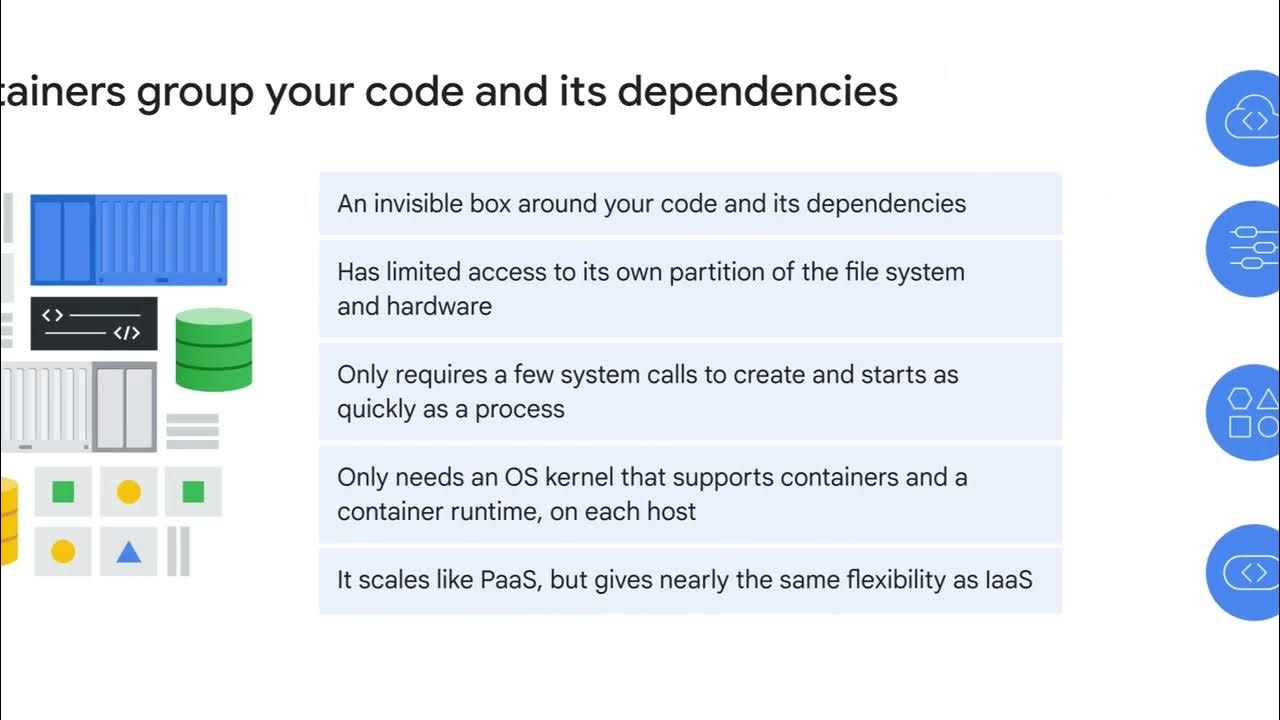Containerizing and Orchestrating Apps with GKE
Summary
TLDRThis section introduces containerization and orchestration using Google Kubernetes Engine (GKE). It explains how GKE combines the flexibility of Infrastructure as a Service (IaaS) with the developer-oriented features of Platform as a Service (PaaS). The video highlights the benefits of containers, including fast scalability and portability, allowing developers to move applications seamlessly across environments. It also discusses Kubernetes, an open-source container orchestration tool, and how GKE simplifies container management, enabling efficient deployment and scaling of containerized applications in both cloud and on-premises environments.
Takeaways
- 🚀 GKE (Google Kubernetes Engine) combines managed infrastructure of IaaS with the developer focus of PaaS.
- 🖥️ Containers virtualize the operating system and hardware, enabling scalability and modularity in apps.
- ⏱️ Containers start much faster than virtual machines, taking only seconds to boot.
- 🌐 Kubernetes is a powerful orchestration tool for managing containerized environments at scale.
- 🔄 Containers offer flexibility for development, allowing code to move easily between development, staging, and production environments.
- 📦 Docker is the tool used for packaging applications in containers, making them portable across different platforms.
- 🔗 Microservices architecture benefits from containerization, as it allows each service to be scaled and deployed independently.
- 💡 GKE simplifies container management by automating deployments, scaling, rollouts, and monitoring of containers.
- 📊 Kubernetes and GKE allow for efficient resource management and flexibility, supporting both cloud and on-premises deployments.
- 🌍 Google uses containers for nearly all its services, launching over 2 billion containers weekly across its infrastructure.
Q & A
What is containerization and how does it relate to GKE?
-Containerization is the process of packaging an application and its dependencies into a container, which allows for independent scalability and portability. GKE (Google Kubernetes Engine) is a managed environment for deploying containerized apps, providing orchestration and cluster management for containers.
How does GKE sit conceptually between IaaS and PaaS?
-GKE combines the managed infrastructure capabilities of IaaS (Infrastructure as a Service) with the developer-friendly aspects of PaaS (Platform as a Service). It allows developers to manage infrastructure while also providing scalable container orchestration.
What are some differences between using VMs and containers for scaling applications?
-Using VMs for scaling requires copying an entire VM, including the guest OS, which can be slow and resource-intensive. Containers, on the other hand, start as quickly as a process, are lightweight, and can be deployed much faster, making them more efficient for scaling applications.
What advantages do containers have over traditional VMs in terms of resource usage?
-Containers require fewer resources because they share the host OS kernel, and they start much faster compared to VMs. This allows for more efficient use of compute resources and faster scaling in response to demand.
How does Kubernetes help in managing containerized environments?
-Kubernetes is a container orchestration tool that simplifies the management of containerized environments by handling container networking, data storage, rollouts, rollbacks, and monitoring host health, thereby making large-scale deployment and management easier.
What is the main benefit of using microservices architecture with containers?
-Using microservices architecture with containers allows developers to break down an application into smaller, independent components that can be deployed, scaled, and updated separately. This modularity makes the application more scalable and easier to manage.
How does GKE leverage Google’s experience in managing large-scale containerized workloads?
-GKE leverages Google’s extensive experience in running applications at scale, using technologies like Kubernetes that were inspired by Google's internal systems. Google runs over 2 billion containers per week, and GKE applies this knowledge to offer automated operations and resource efficiency.
What role does Docker play in containerization?
-Docker is a tool that packages applications and all their dependencies into a container. This makes the application portable, allowing it to be run anywhere that supports Docker containers, such as on a laptop, server, or cloud provider.
How does Kubernetes enable scaling and manage failures in containerized environments?
-Kubernetes manages container clusters by scaling them up or down based on demand, starting or stopping containers as needed, and automatically recovering from host failures. This ensures high availability and efficient resource utilization.
What are some features of Google Kubernetes Engine (GKE) that enhance developer productivity?
-GKE provides features like automated operations, resource efficiency, cluster management, and orchestration of Docker containers. It offers Google's innovations to accelerate time to market, enabling developers to focus on writing code rather than managing infrastructure.
Outlines

此内容仅限付费用户访问。 请升级后访问。
立即升级Mindmap

此内容仅限付费用户访问。 请升级后访问。
立即升级Keywords

此内容仅限付费用户访问。 请升级后访问。
立即升级Highlights

此内容仅限付费用户访问。 请升级后访问。
立即升级Transcripts

此内容仅限付费用户访问。 请升级后访问。
立即升级5.0 / 5 (0 votes)






